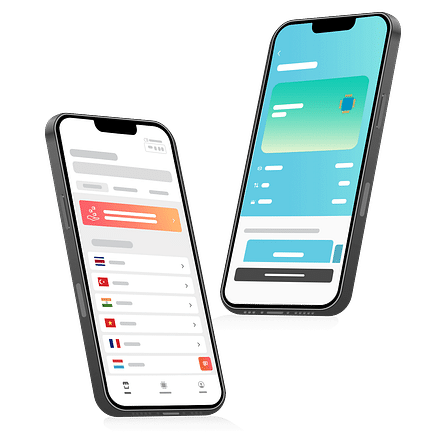
Ready to take on the famous Mt. Tapyas steps and unlock some of the best views Coron has to offer?
This guide is your trusty companion for conquering those 700+ stairs, packed with everything you need.
From what to bring (yes, we’ll talk about the magic of an eSIM for staying connected) to when to go, how to pace yourself, and what incredible sights await you at the view deck.
Along the way, you’ll get tips on navigating patchy Wi-Fi, snapping stunning photos, and soaking in the local vibe without missing a beat.
So lace up your hiking shoes, grab your sense of adventure, and let’s climb to the top together!
What to Bring Before You Hike Mt. Tapyas
Philippine eSIM
Coron’s charm isn’t in its Wi-Fi but in its raw, off-the-grid beauty. That said, staying connected matters for maps, emergency calls, and uploading that hard-earned summit shot.
A local Philippine eSIM gives you stable mobile data where Wi-Fi simply doesn’t reach, like mid-hike or right at the view deck.
Here’s why a Philippine eSIM is a solid travel companion:
- Budget-friendly: About $1.50 per day for 20 GB of data. Other plans available.
- Quick activation: Get connected the moment you land with no shops or SIM trays involved.
- Dual SIM freedom: Keep your original SIM in while using local data on the eSIM.
- Reliable coverage: Stay online even in remote or elevated spots like the Mt. Tapyas view deck.
- Secure connection: Avoid risky public Wi-Fi and browse safely on mobile data
- Flexible plans: Choose data packages that match your trip length and style.
Whether you're checking the weather, messaging your hotel, or just trying not to get lost after the hike, a local eSIM keeps your trip smooth and safe.
Asia Regional eSIM
If Coron’s just one stop on your Southeast Asia adventure, an Asia regional eSIM is worth considering.
It works across multiple countries, so you won’t be juggling SIM cards or chasing local shops every time you cross a border.
Why go regional with your eSIM?
- Budget-friendly: About $1.03 per day for 100 GB of data. Other plans available.
- Multi-country coverage: Use one eSIM for the Philippines, Thailand, Vietnam, Indonesia, and more
- No swapping hassle: Stay connected without removing or replacing SIM cards as you travel.
- Effortless setup: Activate once and you're good across the region.
- Reliable connection in transit: Whether you’re ferrying from Palawan or flying to Bali, stay online without interruptions
- Cost-effective bundles: Regional plans often save you money compared to buying multiple local eSIMs.
You’ll not only stay connected on Mt. Tapyas, but also when you fly out to El Nido, Bangkok, or Bali. It’s one less thing to manage, and when you're on the road, that peace of mind is golden.
Proper Hiking Footwear
Trust me: your footwear can make or break this hike.
Those concrete steps up Mt. Tapyas may look straightforward, but when they’re slick from rain or morning dew, you’ll be glad you chose function over fashion.
Unsplash
Flat sandals, flip-flops, or worn-out sneakers won't cut it. Choose shoes with solid grip and ankle support so you’re stable whether climbing up or walking down.
Blisters and twisted ankles are buzzkills on any trip, and Mt. Tapyas doesn’t have rescue services waiting at every turn.
Even a lightweight pair of trail runners or cushioned walking shoes can go a long way in keeping your hike enjoyable and safe.
Lightweight and Breathable Clothes
You’re in Palawan, so heat and humidity are part of the deal. Wearing clothes that trap sweat is a fast track to a miserable hike.
Opt for breathable fabrics like moisture-wicking athletic wear or loose cotton tops that allow airflow.
You’ll want something that keeps you cool as you tackle over 700 steep steps, especially if you're heading up during the midday sun.
While the hike isn’t overly technical, the tropical climate adds intensity. Dressing smartly makes you feel more comfortable and helps you conserve energy.
A good rule of thumb? If it’s something you'd wear on a jog in 85°F weather, you're probably set.
Water and Snacks
Hydration is non-negotiable. The hike may only take 30 to 45 minutes, but that doesn’t mean it’s a breeze, especially under the tropical sun.
Bring a refillable water bottle (bonus points if it’s insulated) to stay cool and eco-conscious. There’s no water available once you’re on the stairs, so whatever you bring up is what you’ve got.
Toss in a small energy bar or a banana if you tend to run low on fuel quickly. You may not feel hungry at first, but halfway up, your body will thank you for the pick-me-up.
Plus, nothing beats reaching the top, catching your breath, and enjoying a little snack with that epic view.
Power Bank and Flashlight
Coron is known for random brownouts and occasional signal drops, so coming prepared with a fully charged power bank is smart.
Unsplash
Even if you’re only using your phone for photos, that sunset lighting can burn through your battery fast. And if you're planning a late hike, a flashlight or the flashlight feature on your phone is your backup hero.
The stairs aren’t lit after dark, and navigating them in low light without a torch is not only tricky but dangerous.
Whether you’re documenting the journey or just need to stay in touch, having extra juice and light could make all the difference.
Staying Connected While in Coron
Why Wi-Fi Isn’t Reliable at the Top (or Bottom)
Coron's stunning landscapes come with a catch: internet connectivity can be unreliable, especially atop Mt. Tapyas.
Due to its elevation and the island's rocky terrain, Wi-Fi and even mobile signals often drop out, both at the summit and near the base.
This isn’t just inconvenient but potentially risky. The risks extend far beyond slow internet speeds, as this connectivity issue forces travelers to rely on public Wi-Fi networks heavily.
Due to poor security, public Wi-Fi hotspots are common targets for cybercriminals using “man‑in‑the‑middle” attacks to intercept users’ data. This could mean compromised passwords, exposed location data, or even identity theft.
In fact, a study revealed that 4 in 10 travelers have had their online security compromised due to poor Wi-Fi security. So, if you're depending on public Wi-Fi in Coron, you could be opening the door to unwanted cyber guests.
The solution isn't avoiding connectivity altogether, but finding a secure alternative that doesn't rely on public networks.
How Philippine eSIMs Save the Day
Given Coron's connectivity challenges and poor Wi-Fi security, many travelers turn to local physical SIM cards for mobile data.
Unfortunately, these come with significant drawbacks that can disrupt your travel flow. You'll need to hunt down a shop (not always easy in remote areas), present your ID for registration, and wrestle with tiny SIM trays.
Physical SIMs also struggle with inconsistent coverage in Coron's elevated and rocky terrain. This may leave you potentially stranded without a signal at crucial moments.
A Philippine eSIM from Airalo solves this problem. It installs instantly through a simple QR code, activates immediately, and connects directly to the country's strongest mobile networks without requiring a physical SIM to lose or damage.
That way, you get reliable data for maps, rideshares, and translation tools while keeping your original number and SIM intact.
Offline Maps and Backup Tools for Navigation
Since Wi-Fi can be patchy, downloading offline maps before your trip is a lifesaver. Apps like Google Maps let you save the Coron area so you can navigate the Mt. Tapyas trail even without a data connection.
Along with offline translation apps and a portable charger, these tools keep you safe and informed, making sure you never lose your way while fully immersing yourself in the adventure.
The Mt. Tapyas Trail Experience
Where It's Located and Why It's Famous
Mt. Tapyas rises above the heart of Coron Town on Busuanga Island in Palawan, Philippines. It's hard to miss, especially with the massive white cross perched near its summit, which lights up at night and can be seen from nearly every corner of town.
For travelers looking for a light adventure with unforgettable views, this spot is a go-to. It's free to access, easy to find, and doesn't require any guides or permits, making it one of the most accessible scenic hikes in the region.
The panoramic view at the top, stretching out over Coron Bay, limestone cliffs, and scattered islets, is nothing short of epic. Locals love it, travelers rave about it, and if you're planning a trip to Coron, this hike should absolutely be on your radar.
It's also an excellent place to catch sunrise or sunset, and the golden hour up there is magic.
How Many Steps? (Spoiler: Over 700!)
You'll climb exactly 721 concrete steps to reach the summit of Mt. Tapyas.
It sounds like a lot, and it is, but the path is well-maintained, with metal railings and benches placed along the way for quick breathers. Many climbers use these as motivation, especially when it still feels out of reach.
Each step feels like progress, and every few minutes you're rewarded with glimpses of the view stretching farther and wider behind you. The trail itself is straightforward, but you'll want to pace yourself, especially in the midday sun.
Fortunately, the climb is broken into manageable sections, so you're never too far from a place to pause. It's a little workout with a big payoff at the top.
The trail doesn't require technical hiking skills, but it does demand stamina and a steady pace. It's totally doable for beginners and casual travelers, especially if you take your time.
How Long Does the Hike Take
If you're in decent shape and used to walking uphill, the hike to the summit usually takes around 20 to 30 minutes.
That said, it's not a race. Many travelers take 40 minutes or more, especially if they're stopping to enjoy the views, snap photos, or just catch their breath.
Even first-time hikers or those with moderate fitness can reach the top. Just take your time, bring water, and wear the right shoes. For those who prefer a slower pace or are sensitive to heat, expect to take closer to an hour.
You'll still get there, and you'll still love what you see. Don't worry if you need to stop often; each break is just another excuse to soak in the scenery.
The View Deck: What's Waiting at the Top
At the top of the summit, you’ll be welcomed by not just a physical pause, but a visual reward.
With benches, flat ground, and sweeping views of the bay already in sight, the view deck is the perfect place to catch your breath.
Some hikers use this spot to gauge their energy, deciding whether to continue or simply enjoy the partial view and head back. But for most, the sight of the summit cross above and the winding path ahead is enough encouragement to press on.
Reach the top, and the view deck unfolds into an expansive platform offering stunning 360-degree views of Coron Bay and the colorful town below.
The emerald waters, dotted with limestone islands, shimmer in the light, while the bustling harbor adds a sense of vibrancy to the scene.
Whether you arrive in the soft glow of morning or during a golden Palawan sunset, this viewpoint delivers postcard-perfect panoramas in every direction.
The viewing deck is well-maintained, quietly reinforcing the sense that this isn’t just a scenic stop, but a place locals take pride in.
What's That Giant Cross All About?
The giant white cross standing tall at the summit is more than just a landmark; it's a symbol of hope and faith for locals and visitors alike.
Built decades ago, this towering cross draws both pilgrims and tourists who see it as the ultimate marker of accomplishment after the climb.
It's a quiet reminder of the community's spiritual roots and serves as a peaceful spot to pause, reflect, and take in the spectacular views. Plus, it's impossible to miss and makes for an iconic photo backdrop.
Best Time to Hike Mt. Tapyas
Sunrise or Sunset? Choosing the Golden Hour
If you're chasing that golden glow, timing your hike around sunrise or sunset is key. Sunrise offers a quieter, cooler start to your day, with a peaceful sky gradually warming up in pinks and oranges.
The early morning air feels fresh, and the trail is mostly empty except for a few determined locals or early-bird travelers. It’s the perfect moment to reflect as the town of Coron slowly wakes up beneath your feet.
Sunset, on the other hand, is the more popular option, and for good reason. The sun dips behind the jagged silhouettes of Coron’s karst islands, casting dramatic shadows over the bay.
You’ll probably share the view with fellow hikers, but the energy is lively and communal. Just remember to bring a flashlight if you plan to descend after dark.
Weather Tips: Dry Season vs Rainy Season
The best time to hike Mt. Tapyas is during the dry season, when the trail is safer and the views are far more rewarding. While it’s still possible to hike year-round, timing your climb well can make a big difference in the overall experience.
- Best season: November to May (dry season) offers clear skies, consistent sunshine, and better visibility
Trail conditions: Stairs are dry and less slippery, making the climb more enjoyable and safer - Weather predictability: Fewer chances of surprise rain showers or sudden storms
- Rainy season (June to October): Trail can be slick due to moss or mud buildup
- Views may be limited: Cloud cover often obscures the landscape, especially in the afternoons
- If hiking during rainy months: Go early in the morning and always check the weather forecast before starting
Stay Connected, Stay Adventurous
Climbing Mt. Tapyas is an experience you won’t forget, but don’t let spotty Wi-Fi slow down your adventure.
Having a reliable Philippines eSIM from Airalo means you can keep your maps, messages, and memories flowing seamlessly even in the most remote corners of your trip.
Here’s why a Philippines eSIM from Airalo is a travel essential:
- Instant activation with no SIM swapping headaches
- Consistent data coverage
- Affordable plans that keep your budget happy
- Freedom to roam without hunting for Wi-Fi spots
So, get your eSIM ready, hit those steps with confidence, and enjoy every breathtaking moment without missing a beat.
FAQs about hiking Mount Tapyas
Is there a pavilion on Mount Tapyas
No, there isn’t. The only available resting area is the viewing deck, where you can sit at the benches while enjoying the view.
Is it safe to hike Mt. Tapyas alone?
Yes, the trail is safe and well-used, especially during peak hours, but avoid hiking alone at night.
Is there an entrance fee to Mt. Tapyas?
No, it’s free to hike and open to the public.
Is the trail suitable for beginners?
Yes, but be prepared for a steady uphill climb with no shade for much of the route.



